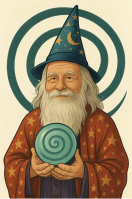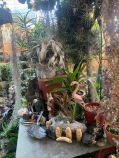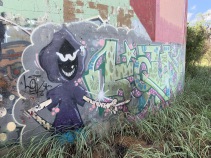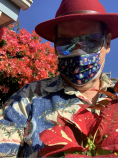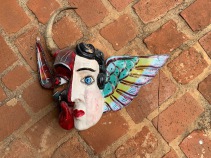Notes for "The Neglected Phases"
First a poem of sorts:
Of Breath and Stone
by Richard M. Valasek, with a ghost
We do not sort the tangle.
We enter it.
With breath like a bellows
and bones learned from stone,
we speak of the hand
before it holds,
of the step
before it strikes the ground.
Each gesture is a ghost of instruction.
Each scar is a lesson in skin.
Each tool
--a shadow limb--
remembers the body that reached for it.
Let no name seal the thing.
Let the thing remain fluid,
the name a tidepool,
not a cage.
We kneel at the seam
where living tissue meets practiced form.
We say: this is not muscle,
this is memory braided in tendon.
This is the cry of the wound
echoing through a splint.This is the breath, trained to yield
and the body, learning again to fall.
We do not sort the tangle.
We listen to it hum.
We dance
on its frayed edge.
We become the knot
and let it move.
Not Just for Fun: Phase 2, Phase 3, and the Architecture of Possibility
Appendix: From "The Philosophy and History of Ortho-Bionomy" (revised edition) by Arthur Lincoln Pauls
Phase One
Examine the trigger points as listed for each specific area. Let's choose one to seven in the cervical region. With the client in supine position, pick a trigger. Don't forget that there are also anterior triggers as well as posterior. Press the trigger points gently and the client will usually confirm tenderness there. Now, move the head in different directions until both you and the client have agreed that it feels the best it can in that position. Look at the clock on the wall. Hold the head for exactly 90 seconds, being careful not to change the position. When the time is up, very slowly move the head back to the neutral starting place. Re-examine the trigger point. The tenderness will have decreased or disappeared if you were successful in the positioning confirmed by you and your client. Congratulations! You have performed all the necessary requirements of a scientific mind that demands to know what it is doing. Do all your work like this and it will stay as work. It will also keep you at Square One. Like a chess game, real life may start from a limited number of initial positions, but from there the variety of possible moves are infinite. But don't worry: many of the things done in this world are taught at Square One level. You will have endless friends who join Square One clubs and who enjoy their work. Square One is a safe place to be. It is a framework that gives you room to move, so long as you stay in the confinement of the square. If you are daring enough, you can join the Enclosed-Round club, running around in circles and wonder why you are going nowhere. One day, however, you may want nothing less than to launch yourself into space.
Phase Two
Observation: I keep hearing the same words screaming in my ear while I am doing Phase One—Boring!! Boring! BORING!!! Why? Why always three times? Why? Why?? Why??? Can't we turn work into play? Maybe there would be some fun! Fun!! FUN!!! in it. But the idea is childish. Who would seriously listen to a child?
Wait a minute! Didn't a childish mind once call the Founder of Ortho-Bionomy "the Flounder"? And didn't that Flounder (a type of bottom-feeding fish) state that the best student of Ortho-Bionomy would be a seven-year-old child who knew NOTHING?
I got it! I'll play around with the idea of less time. I'll only hold a position for 60 seconds. Maybe I'll even just close my eyes and pretend I can guess the right time. Sounds crazy and unscientific. Wait a minute! Doesn't the word diagnosis mean scientific GUESS? What if I fail? Terrible! I'd be laughed at in the Square One Club! A thought just hit me—I could cancel my membership and instead join the Round Circle Club!
It makes me feel a bit silly, but Phase Two feels a bit more like fun and a bit less serious. Didn't someone say that "All work and no play makes Johnny a dull boy!"?
OK. Maybe I'm getting the idea—sometimes it's work and sometimes fun. Wait a minute! I'm using the word work again. Maybe I could cheat a little and open the circle a little and let in a little fresh idea. What if I get thrown out of the Round Circle Club? Cast out into the darkness! The Circle Club, at least, is one rung up the ladder.
Phase Three
Since I pried the circle open, I like the FUN of playing with the new ideas that come and go—but not too much. When I enter my states of fear, I close the circle again, so I can feel safe from the prying minds that wonder what I am doing. I haven't got all the answers to questions I am asked. Who has? I would not be considered responsible.
Yet, sometimes I notice when I pick a trigger out of the hat to evolve again, I get a better result. But then I ask myself: Can I do a real job on chance or luck? Maybe I have a choice here. I can think of running around in circles, prying them open in places, or I can—dare I say it—spiral onwards to new circles with only open ends. Wait a minute! What if I launch myself into space as the Founder/Flounder suggested? What if I could not find a safe landing place? Could I take a parachute? Wait again! The line goes on about "the only real courage." What is real courage anyway? I am in a state of fear and someone talks about being a "hero"? Don't heroes have any fear? A famous theatrical actor once stated that when you lose your stage fright before you perform, you would never be a good actor again.
Something to ponder? Of course, it's so simple: "The play's the thing!" Who led you to it, or why and how you arrived at it, is not important. You did it.
Take the misunderstanding. Drop the mis- and there it is again. Understanding! It is always there; we ourselves hit it with our fear.
Phase Four
Okay, Phase Four, open the door. The verse is from a poem that goes something like this:
Phase One—it's just begun!
Phase Two—what to do?
Phase Three—it's up to me
Phase Four—open the door!
Phase Five—man alive!
Phase Six—this is bliss!
Phase Seven—this is heaven!
Phase Eight—we'll have to wait!
A whole class in Chicago formulated that little jingle in the 1980s. Now I am at Phase Four, with the door open. I can see all kinds of things I never dreamed existed.
I don't have to worry about time, triggers, or which one is first, and so on. My hands just touch and away they go, moving here and there. It's constantly amazing to me, like a dance I'm making up the moves. So infinite and beautiful to behold. Experiencing patterns that cannot be cataloged, but which dance on to the spiraling light of reality. Now it becomes the play that I used to pray for. Instead of praying now for things as I want them, I accept those I play with and myself for what they are.
Phase Four then becomes the open door through which we step out into the garden of life, full of sunshine and rain, beautiful flowers and weeds, saints and sinners—all blended together to form whatever we choose to see in our mirrored images. Enjoy, play, and love.
